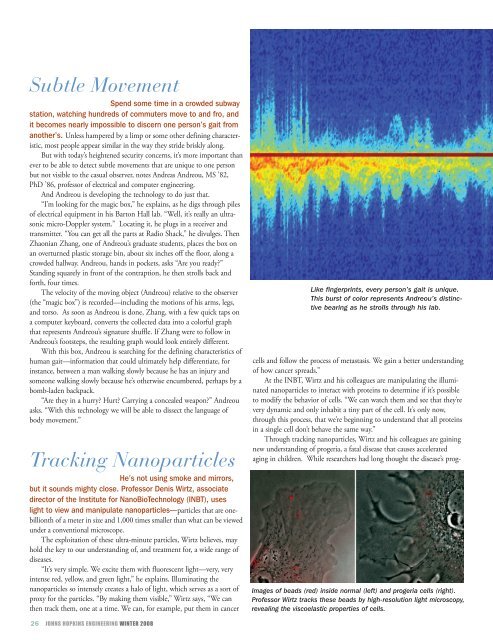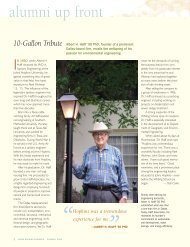Whither the Job Market?: - Johns Hopkins University Whiting School ...
Whither the Job Market?: - Johns Hopkins University Whiting School ...
Whither the Job Market?: - Johns Hopkins University Whiting School ...
You also want an ePaper? Increase the reach of your titles
YUMPU automatically turns print PDFs into web optimized ePapers that Google loves.
Subtle Movement<br />
spend some time in a crowded subway<br />
station, watching hundreds of commuters move to and fro, and<br />
it becomes nearly impossible to discern one person’s gait from<br />
ano<strong>the</strong>r’s. Unless hampered by a limp or some o<strong>the</strong>r defining characteristic,<br />
most people appear similar in <strong>the</strong> way <strong>the</strong>y stride briskly along.<br />
But with today’s heightened security concerns, it’s more important than<br />
ever to be able to detect subtle movements that are unique to one person<br />
but not visible to <strong>the</strong> casual observer, notes Andreas Andreou, MS ’82,<br />
PhD ’86, professor of electrical and computer engineering.<br />
And Andreou is developing <strong>the</strong> technology to do just that.<br />
“I’m looking for <strong>the</strong> magic box,” he explains, as he digs through piles<br />
of electrical equipment in his Barton Hall lab. “Well, it’s really an ultrasonic<br />
micro-Doppler system.” Locating it, he plugs in a receiver and<br />
transmitter. “You can get all <strong>the</strong> parts at radio Shack,” he divulges. Then<br />
Zhaonian Zhang, one of Andreou’s graduate students, places <strong>the</strong> box on<br />
an overturned plastic storage bin, about six inches off <strong>the</strong> floor, along a<br />
crowded hallway. Andreou, hands in pockets, asks “Are you ready?”<br />
Standing squarely in front of <strong>the</strong> contraption, he <strong>the</strong>n strolls back and<br />
forth, four times.<br />
The velocity of <strong>the</strong> moving object (Andreou) relative to <strong>the</strong> observer<br />
(<strong>the</strong> “magic box”) is recorded—including <strong>the</strong> motions of his arms, legs,<br />
and torso. As soon as Andreou is done, Zhang, with a few quick taps on<br />
a computer keyboard, converts <strong>the</strong> collected data into a colorful graph<br />
that represents Andreou’s signature shuffle. If Zhang were to follow in<br />
Andreou’s footsteps, <strong>the</strong> resulting graph would look entirely different.<br />
With this box, Andreou is searching for <strong>the</strong> defining characteristics of<br />
human gait—information that could ultimately help differentiate, for<br />
instance, between a man walking slowly because he has an injury and<br />
someone walking slowly because he’s o<strong>the</strong>rwise encumbered, perhaps by a<br />
bomb-laden backpack.<br />
“Are <strong>the</strong>y in a hurry? Hurt? Carrying a concealed weapon?” Andreou<br />
asks. “With this technology we will be able to dissect <strong>the</strong> language of<br />
body movement.”<br />
Tracking Nanoparticles<br />
he’s not using smoke and mirrors,<br />
but it sounds mighty close. professor denis Wirtz, associate<br />
director of <strong>the</strong> institute for nanobioTechnology (inbT), uses<br />
light to view and manipulate nanoparticles—particles that are one-<br />
billionth of a meter in size and 1,000 times smaller than what can be viewed<br />
under a conventional microscope.<br />
The exploitation of <strong>the</strong>se ultra-minute particles, Wirtz believes, may<br />
hold <strong>the</strong> key to our understanding of, and treatment for, a wide range of<br />
diseases.<br />
“It’s very simple. We excite <strong>the</strong>m with fluorescent light—very, very<br />
intense red, yellow, and green light,” he explains. Illuminating <strong>the</strong><br />
nanoparticles so intensely creates a halo of light, which serves as a sort of<br />
proxy for <strong>the</strong> particles. “By making <strong>the</strong>m visible,” Wirtz says, “We can<br />
<strong>the</strong>n track <strong>the</strong>m, one at a time. We can, for example, put <strong>the</strong>m in cancer<br />
26 JOHNs HOpkiNs ENGiNEERiNG WiNTER 2008<br />
Like fingerprints, every person’s gait is unique.<br />
This burst of color represents Andreou’s distinctive<br />
bearing as he strolls through his lab.<br />
cells and follow <strong>the</strong> process of metastasis. We gain a better understanding<br />
of how cancer spreads.”<br />
At <strong>the</strong> INBT, Wirtz and his colleagues are manipulating <strong>the</strong> illuminated<br />
nanoparticles to interact with proteins to determine if it’s possible<br />
to modify <strong>the</strong> behavior of cells. “We can watch <strong>the</strong>m and see that <strong>the</strong>y’re<br />
very dynamic and only inhabit a tiny part of <strong>the</strong> cell. It’s only now,<br />
through this process, that we’re beginning to understand that all proteins<br />
in a single cell don’t behave <strong>the</strong> same way.”<br />
Through tracking nanoparticles, Wirtz and his colleagues are gaining<br />
new understanding of progeria, a fatal disease that causes accelerated<br />
aging in children. While researchers had long thought <strong>the</strong> disease’s prog-<br />
Images of beads (red) inside normal (left) and progeria cells (right).<br />
Professor Wirtz tracks <strong>the</strong>se beads by high-resolution light microscopy,<br />
revealing <strong>the</strong> viscoelastic properties of cells.





